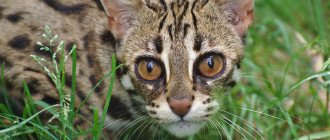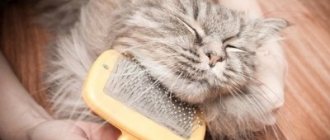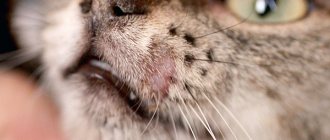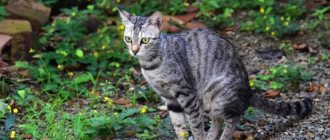Description
The coat color varies from brown to red. Females are generally lighter than males. The belly is white and, like African golden cats, decorated with many small spots. Vertical dark lines extend above the eyes. A distinctive feature of the species are elongated ears with black bones. The legs are relatively long, the hind limbs are longer than the forelimbs, and have well-developed muscles. Eye color varies from golden or copper to green or gray. Melanism has been documented in individuals of this species, but is extremely rare. Juveniles are distinguished by their shorter ear tufts and blue eyes. Females weigh no more than 13 kg, while males can weigh up to 20 kg. Even though the tail is short, it still makes up a significant portion (18 to 34 cm) of the total body length including the head (62 to 91 cm). Even the smallest adult caracal is larger than most domestic cats.
Subspecies
- C. c. algira - Algeria, Libya, Morocco, Tunisia;
- C. c. caracal - central Africa and South Africa;
- C. c. damarensis - Namibia;
- C. c. limpopoensis - Botswana and northern South Africa;
- C. c. lucani - northern Angola, Democratic Republic of the Congo, Gabon and Republic of the Congo;
- C. c. nubica - Cameroon, Ethiopia and southern Sudan;
- C. c. poecilotis - Senegal, Nigeria, Niger and western Sudan;
- C. c. schmitzi - Afghanistan, western India, Iran, Iraq, Israel, southwestern Kazakhstan, Kuwait, Lebanon, Oman, Pakistan, Qatar, Russia, Syria, southern Turkey, Turkmenistan, UAE, southwestern Uzbekistan.
Appearance
There are 9 types of caracals, but it is impossible to distinguish them with the naked eye without professional knowledge. All of them are quite tall. At the withers, height reaches an average of about 50 cm.
With this height, the cat does not look large, as it has a very graceful build.
- The head has an elongated shape and small size. The muzzle is extended forward and covered with spots.
- The animal's ears are narrow and long, located at a great distance from each other, and stand upright. Ear color is black. There are tassels on the sharp tips. The back of the ears is black, sometimes with slight graying, in color.
- The eyes are almond-shaped and have a yellowish tint. They are edged with a black stripe.
- The cat's body is slender and muscular. The body length is approximately 65-85 cm.
- The caracal has slender, large paws of medium length.
- The tail is long and quite mobile. It is shorter in length than half the cat's body.
- The short, thick coat is red or sandy-red in color. It is slightly longer on the stomach and chest. There is a yellow stripe under the cat's eyes. Males and females have the same color.
An adult cat can weigh approximately 16-20 kg. Caracals live for about 15 years.
American Curl - description of the breed and character of the cat
Habitat
Caracals occupy a variety of habitats. Typically, they are found in wooded areas, thickets and bushes, plains and rocky slopes. These cats prefer the outskirts of their habitats, especially forest/meadow crossings. Steppe lynxes are found at altitudes of over 3,000 meters in the mountains of Ethiopia. An arid climate with minimal leaf cover is preferred. Compared to servals, caracals can live in drier conditions. However, they rarely live in desert or tropical areas. In Asia, they are sometimes found in forests, which is rare for African populations.
Reproduction
Before mating begins, chemical signals in the female's urine attract the male and notify him that she is ready to mate. The distinctive cough-like vocalization is also a way of attracting mates. Several different forms of mating systems characteristic of the species have been observed. When several males are courting a female, there may be a struggle between them for the right to mate, or the female may choose a partner on her own, preferring older and larger ones over young and small ones. Once paired, caracals stay together for four days and mate frequently. Copulation lasts on average less than five minutes. Cats almost always mate with more than one male. For males, infanticide is observed, after which the female, prematurely, begins estrus and ends lactation.
Although both sexes become sexually mature at 7 - 10 months, the earliest successful mating occurs at 14 - 15 months of age. Some biologists believe that sexual maturity is indicated by a body weight of 7 to 9 kg. Females exhibit estrus behavior for 3 to 6 days, but in reality, it lasts twice as long. Estrus can begin at any time during the year. Pregnancy lasts 68 - 81 days, and the number of kittens in the litter varies from 1 to 6. In the wild, as a rule, no more than 3 cubs are born, while in captivity, there are more of them, but rarely exceed 6 kittens.
Parental education plays a large role in reproductive behavior. The time a mother spends with her kittens (and the absence of postpartum estrus) limits the female to one litter per year. Once pregnancy occurs, the male plays no role in rearing. Mothers invest a lot of time and energy into their offspring. Holes in trees, caves, or abandoned burrows are often chosen for the birth of young and the first four weeks of their lives. A month later, the cubs come out of hiding. Around this time, kittens begin to play and eat meat. Breastfeeding continues until the kittens reach 15 weeks of age, but full independence occurs at 5 to 6 months.
Cat care
Keeping a caracal at home requires certain costs and special attention. The animal loves freedom, so it is recommended to equip an enclosure with an area of about 20 square meters. There should be all kinds of “simulators” and a scratching post in the room so that the animal can play and be in good shape.
Caring for a pet requires monitoring its appearance: the cat must be clean and well-groomed. To maintain good hygiene, it is advisable to brush the desert lynx once a week.
Bathing should also be done rarely; an increase in the number of water procedures is provided in case of severe contamination of the coat. While bathing, you can throw toys into the water to make your pet happy, which he will enjoy playing with. After bathing, it is advisable to inspect the ears and eyes and, if necessary, clean them.
To save yourself from scratches, the claws of the front paws should be removed in advance using a laser in the nursery, but still remember that the animal does not like this process, so you need to make a decision that is beneficial not only to the owner, but also to the cat.
Nutrition
It is recommended to include in your pet's diet:
- fish;
- poultry, rabbit, beef;
- eggs – only once a week;
- grass - about 1-2 times a week;
- sea fish - once a week.
Exclude:
- salty foods;
- food with added spices;
- sweet;
- sausages.
Use dry food as feeding. Before choosing this food item, consult your veterinarian and buy quality options.
Due to periodic changes in the cat's menu, rodents may appear in it, since they are also food for predators. In addition to solid food, young kittens are advised to give vitamins and foods containing calcium.
It is advisable to feed the caracal no more than 2 times a day. Food should always be fresh and served in portions. It is recommended to prepare food for the animal separately and not accustom it to food from the owner’s table.
It is not recommended to feed pork meat to prevent the risk of disease.
For an adult male, it is recommended to follow a regular diet once a month: from 1 to 10 days he needs to fast.
Nutrition
Like other cats, caracals are strictly carnivorous. The diet includes: hyraxes, hares, rodents, antelopes, small monkeys and birds. Pigeons and partridges are seasonally important prey. The mountain redunk, Dorcas gazelle, great bustard, common gazelle, gerenuk and Sharp's stenbok are specific examples of animals that steppe lynxes can hunt. They consume some reptiles, although reptiles are not the main component of the diet. Depending on their habitat, the components of their diet change. For example, the African caracal can feed on larger species, such as ungulates, while the Asian caracal can only feed on small vertebrates (for example, rodents). Sometimes they attack domestic animals. Although these cats are known for their spectacular leaps at birds, mammals make up more than half of the diet in all habitats. They can kill prey two to three times their body weight. Small victims are killed by a bite to the back of the head, and large victims are killed by a bite to the throat. Caracals chase prey and then leap on it using their disproportionately long and muscular hind legs. Unlike leopards, they rarely lift a dead carcass into trees.
Lifestyle
Caracal The caracal
is mainly a nocturnal predator. But sometimes he can be found hunting during the day. It is very difficult to spot a caracal during the day. This cat is well camouflaged and senses the approach of people from a distance. She can lie almost motionless for several hours, hiding next to a person.
This cat leads a solitary lifestyle. Males do not stay with the female when she has cubs. Caracals have a large hunting area. They do not allow rivals into their territory, even if they are larger than them. In Africa, caracals are driven out of their range by predators twice their size. Also, these amazing cats can live for a long time without water. They do not suffer from drought. Therefore, during these terrible times for other animals, they, on the contrary, gain weight, as they ambush on trails near small bodies of water. Caracals, like all cats, hiss, meow and growl loudly.
Behavior
These animals can go without drinking for a long time. During the hot hours of the day, they rest, and hunt mainly during the cold hours - morning, night and evening. Their gait is similar to that of cheetahs, but they are not sprinters. Steppe lynxes climb trees if they are being chased by dogs. Although they can be considered the fastest cats in their weight class, when hunting, they sneak quietly and then jump on their prey like house cats.
Caracals are wonderful jumpers and can jump up to 3 meters in height. Thanks to this feature, cats can knock birds to the ground with their paws. They are capable of killing ten to twelve pigeons in one hunt. Once upon a time, these predators were domesticated and trained to hunt birds in India and Iran. They were placed in an arena containing a flock of pigeons, and people placed bets on the number of birds shot down. Caracals were also used to hunt antelope, hares and foxes, as well as cheetahs.
Like most cat species, steppe lynxes are nocturnal and travel up to 20 km per night in search of food. They sleep in burrows, crevices or dense bushes, sometimes in trees.
Home range
Caracals have a fairly large home range for their relatively small body size. Climatic conditions, geographic location and breeding opportunities are the main factors influencing the size of the home range of individuals. The male's territory is usually twice as large as the female's. The size of the home range also depends on the availability of water. In areas with dry climates, the home range is much larger. In some parts of Africa, a male's territory ranges from 31 to 65 km². Females in the same region will maintain a range of 4 to 31 km². In some parts of Asia, males have home ranges of 200 to 300 km². A male's territory may overlap the ranges of several other males, while a female defends her entire territory for her individual use.
How much does a caracal cost?
Representatives of the breed are expensive: in nurseries, a kitten costs from 400,000 to 450,000 rubles. However, the high cost of a Caracal cat is justified not only by its exotic origin, but also by the presence of important documents that allow it to find a loving friend.
Choosing a kitten
In order for a caracal kitten to appear in your home, it is recommended to contact a specialized nursery. In addition to special institutions, it is best to purchase an animal from people who have certificates and the necessary documents for a cat in order to avoid the risk of purchasing a sick animal or one obtained dishonestly through poachers.
Breeders recommend taking a pet under one year old - caracal kittens should be no older than 6 months, so that it is easier for them to get used to their new owners.
If special documents are not attached to the kitten, it is taken away, since keeping such an animal without a passport is prohibited by law.
To summarize all that has been said, we note that choosing a pet is a responsible step, and purchasing a caracal is doubly so. Therefore, before choosing these exotic pets and purchasing them, it is recommended to make sure that it is possible to follow all the necessary rules and precautions in the process of caring for and caring for them.
Communication and perception
There has never been a thorough study of the communication of this species. Most of the information comes from observing individuals kept in captivity. Like other cats, caracals have well-developed senses of hearing and vision. Although servals are known for their incredible hearing, steppe lynxes can also, alone, detect small prey by sound. Once prey is located, they use their keen vision to focus on it. The exact function of the ear tassels is unknown. In captivity, caracals are known for their vocalizations. These cats growl, hiss, spit and meow. Tactile communication is observed in combat, between males, and during the breeding season. A potential partner is attracted to an olfactory signal. Hormonal changes in the female's body lead to changes in the composition of urine. When the female is ready to mate, she marks her territory with her urine, in different places, to attract males, who sense the scent through the vomeronasal organ.
Living in the wild
Caracals prefer to settle in the territory of savannas, as well as in deserted steppe zones and in foothills.
Habitats and geography
A large number of caracals are found in Africa, the Arabian Peninsula, Asia Minor and Central Asia, as well as the Middle East. A small number of steppe lynx inhabits Southern Turkmenistan, the coast of the Caspian Sea and the Mangyshlak Peninsula, as well as the eastern part of Kyrgyzstan and the Bukhara region in Uzbekistan. In our country, single individuals are found in the foothills and deserts of Dagestan.
Lifestyle of the steppe lynx
Steppe lynxes get along well with many other representatives of the cat family . Caracals do not enter desert areas very often, but they are able to easily tolerate drought and go without water for a long time. During the daytime, caracals take refuge from the midday heat in dense thickets, and at nightfall they come out to hunt. The caracal is characterized by a solitary lifestyle, and its own feeding area is strictly protected.
This is interesting! The size of the protected feeding area of an adult steppe lynx is very impressive, and can vary from 4 km to 300 km or more, while females choose relatively small territories for themselves.
Caracals have excellent eyesight and excellent hearing, which allows predators to quietly and very effectively track their prey. After the prey is discovered, the caracal attacks it with almost lightning speed. Despite its well-developed limbs, the steppe lynx cannot pursue its prey for a long time, so the hunting process is carried out from an ambush.
The prey of the caracal can be hares, various rodents, birds, hedgehogs, porcupines, monkeys, small antelopes, mongooses, as well as foxes and all kinds of reptiles. An adult predator is able to cope with prey that is twice the size of a caracal. Small animals are killed with a single powerful bite, while larger prey are usually killed by strangulation. The predator hides the remains of uneaten food and, if necessary, eats it after a while.
The main enemies of the caracal
The steppe lynx can be attacked by large predators such as lions and hyenas, from which caracals escape in dense thickets. The enemies of the caracal also include steppe wolves and Alabai dogs, which are used by people to protect flocks of sheep .
Recently, caracals have been deliberately exterminated by people, due to the need to protect livestock from attacks by predators. The sharp decline in numbers contributed to the inclusion of the steppe lynx on the list of protected species, and hunting for this predator is prohibited in the CIS countries.
Threats
Despite their widespread distribution and relatively large overall population size, in some parts of their range, caracals are considered rare and endangered. Because they are capable of attacking domestic animals, they are often seen as a problem across the spectrum. In North Africa, Arabia, Central Asia, Iran and India, habitat loss poses a serious threat to the survival of this species. In southern Africa, where steppe lynxes are common, they are heavily persecuted as pests due to their habit of preying on domestic animals. However, despite the large number of individuals killed, the population does not seem to be suffering.
Coat color is the main defense against predators. When threatened in open habitats, caracals lie flat on the ground and their smooth, brown fur acts as instant camouflage. Agile tree-climbing abilities help avoid large predators such as lions and hyenas.
Known predators:
- lions (Panthera leo);
- leopards (Panthera pardus);
- hyenas (Hyaenidae).
Distribution and abundance of caracals
The wild croak is widespread in many areas of Africa, inhabiting the Arabian and Anatolian peninsulas, and is found throughout Southwestern and central Asia, Kazakhstan and central India.
These cats are not found in the central part of the Sahara Desert, and they also avoid the dense forests of the equatorial part of West Africa.
The animal is found in the CIS, although not in such numbers as in Africa. Sometimes the karcal is seen in the foothills and deserts of Dagestan, where its population is about 100 individuals.
Economic significance for humans
Positive
In India and Persia, they were once trained to catch game and deer. Thus, cats provided people with food and entertainment. The meat and hides in West and Central Africa provide food and modest income for local people. Fortunately for caracals, their skin is in very low demand.
Negative
Predation on small domestic animals leads to the destruction of thousands of steppe lynxes every year. This is particularly the case in South Africa and Namibia, where predator control programs are lacking.
History of the discovery of the caracal species
The caracal is a predator of the cat family. Africans call the caracal the Barbary lynx. In general, caracals are also called desert cats and steppe lynxes. For a long time, caracals were classified specifically as lynxes, because in appearance these species are very similar. However, later genetic characteristics were found in desert cats that distinguish them from other species. The name “caracal” is translated from the Turkmen language as “black ear” (karakulak).
The caracal got its name from its unusual ears.
Once upon a time, in ancient times, hunters (India, Africa, Persia) took caracals with them to hunt. Poor hunters could not afford to domesticate cheetahs, so the choice fell on small predators: ocelots and caracals. Steppe lynxes could easily catch game (peacocks, pheasants, etc.), hares and antelopes. Desert cats are gentle creatures, so they were easily tamed.
In 1998, a hybrid of a caracal and an Abyssinian cat was born in one of the Moscow zoos. This was an unplanned crossbreeding of cats of different species, so the result was unexpected. And later, in 2007, American felinologists tried to specifically cross these species, but the litter consisted of only one kitten, so the scientists were unable to complete their task (the “Caraket” program). Currently, hybrids of caracals and domestic cats are popular among lovers of exotic animals. They are now recognized as a separate breed by several associations, including the ISU and TICA.
Due to the interesting history of the species, the caracal is still called the “poor man’s cheetah” in India. It is believed that anyone can tame the steppe lynx.
Security status
The Convention on International Trade in Endangered Species (CITES) lists the Asian populations in Appendix I and all others in Appendix II. This means that Asian populations cannot be traded for any commercial gain, but trade for scientific research is permitted. Appendix II dictates that trade in these animals will be controlled and permitted in cases that will not be detrimental to the species.
According to the IUCN Red List, steppe lynxes are classified as a species of Least Concern.
Breed card
| Characteristics of a cat | Notes | |
| General information | Exotic cat breed. The domestication of wild caracals made it possible to obtain offspring that were human-oriented, but retained many of the traits of their ancestors. | The high price of caracals also implies high responsibility. Keeping an unusual cat is not cheap |
| Character | An inquisitive, agile and very active caracal resembles a dog in behavior. The cat loves walking and exploring the territory | Caracals hiss and growl, rather than meow like regular domestic cats. |
| Appearance | Large cat - height at the withers - 50 cm with short honey-colored hair, characteristic dark spots on the face, yellow eyes and large ears with black tassels | Domestic caracals are very similar to their wild relatives |
| Behavior at home | The caracal will explore and try out all the things available to it. There should be several scratching posts in the house so that the cat is not interested in your furniture. Toilet question: it is better for the animal to have access to the yard of a private house; in apartment conditions, accustom your caracal to the tray as early as possible | We do not recommend having a caracal for families with small children, as well as being in proximity to other pets. |
| Care | Feeding raw meat is preferable | Do not forget to freeze the meat for 3 days to kill parasites |
| Health problems | No hereditary diseases were identified | Caracals boast good immunity and almost never get sick. But it’s worth finding a veterinarian in advance who is willing to monitor the health of such a big cat. |










